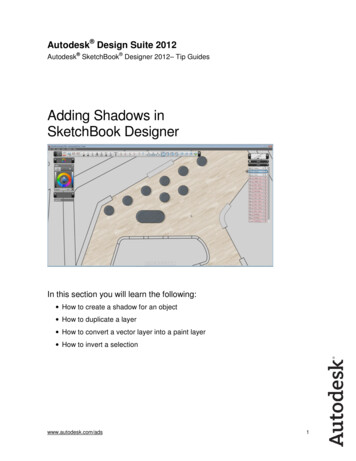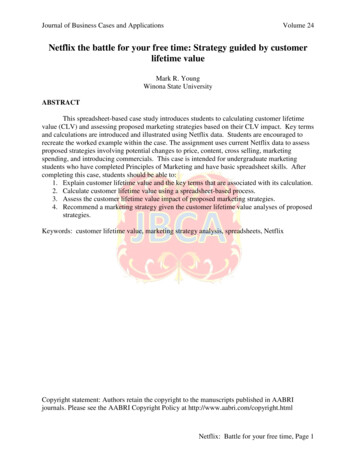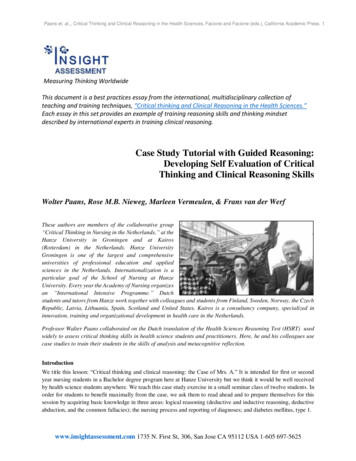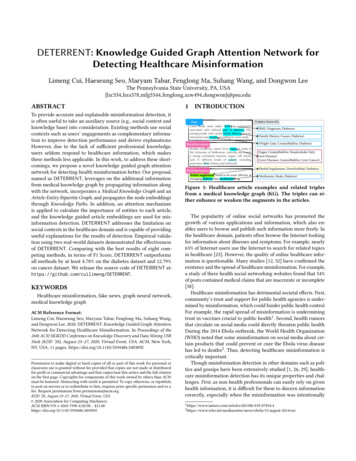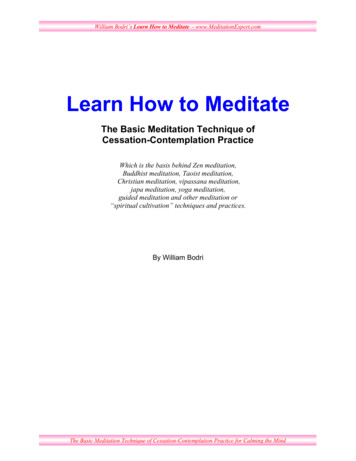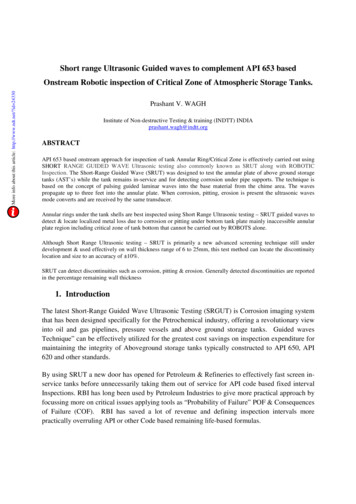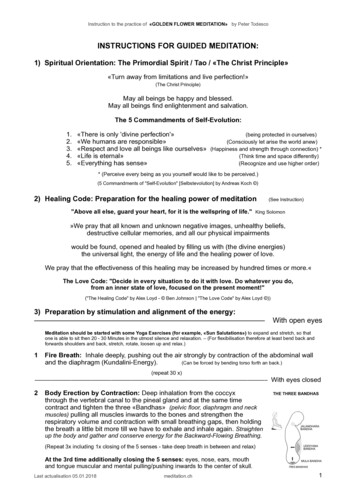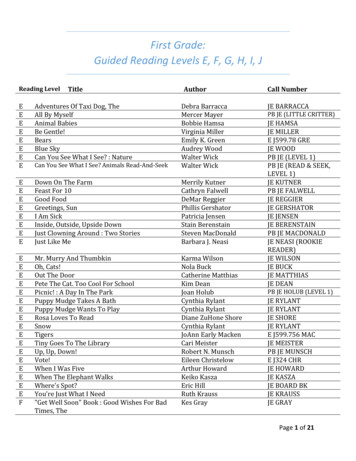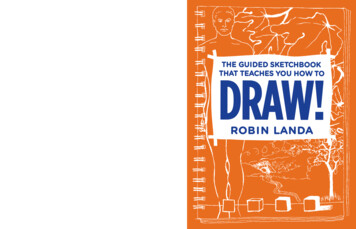
Transcription
Always wanted to learn how to draw? Now’s your chance.Kean University Teacher of the Year Robin Landa has cleverly disguised an entirecollege-level course on drawing in this fun, hands-on, begging-to-be-drawn-insketchbook. Even if you’re one of the four people on this planet who have neverpicked up a pencil before, you will learn how to transform your doodles into realisticdrawings that actually resemble what you’re picturing in your head.In this book, you will learn how to use all of the formal elements of drawing—line, shape, value, color,pattern, and texture—to create well-composed still lifes, landscapes, human figures, and faces.Keep your pencils handy while you’re reading because you’re going to get plenty of drawing breaks—and you can do most of them right in the book while the techniques are fresh in your mind. To keep youinspired, Landa breaks up the step-by-step instruction with drawing suggestions and examples from ahost of creative contributors including designers Stefan G. Bucher and Jennifer Sterling, artist Greg Leshé,illustrator Mary Ann Smith, animator Hsinping Pan, and more.Robin Landa, Distinguished Professor in the Robert Busch School of Design at Kean University,draws, designs, and has written 21 books about art, design, creativity, advertising, and branding.Robin’s books include the bestseller Graphic Design Solutions (now in its 5th edition); Build YourOwn Brand: Strategies, Prompts and Exercises for Marketing Yourself; and Take A Line For A Walk:A Creativity Journal. To connect online, please visit robinlandabooks.com.“Once upon a time, sketching was part of every educated person’s schooling.DRAW! introduces this wonderfultechnique for visual thinking to anyonewho wants to illustrate ideas and images on paper or digital pad.— Stephanie Knopp, Department Chairperson,Tyler School of Art, Temple University“With DRAW!”Landa has done it again:created a book that is educational, entertaining, and interactive all at once.A must-have for the artist in all of us.facebook.com/PeachpitCreativeLearningLEVEL: Beginning / IntermediateCATEGORY: Design / DrawingUS 24.99 CAN 25.99ISBN-13: 978-0-321-94050-6ISBN-10:0-321-94050-4COVERS: Drawing FundamentalsCOVER DESIGN: Denise Anderson and Laura MenzaCOVER ILLUSTRATION: Mitzie Testani and Robin Landawww.peachpit.comAUTHOR SKETCH: Robin Landa9780321 9405065 2 4 9 9LANDA@peachpitDRAW!”— Steven Brower, Designer, Author, Educator, and Director of the“Get Your Masters with the Masters” MFA program, Marywood UniversityTHE GUIDED SKETCHBOOK THAT TEACHES YOU HOW TOTHE GUIDED SKETCHBOOK THAT TEACHES YOU HOW TO DRAW!
The guided sketchbook that teaches you how to DRAW!Robin LandaPeachpit PressFind us on the Web at:Notice of Liabilitywww.peachpit.comThe information in this book is distributedon an “As Is” basis without warranty.To report errors, please send a note to:While every precaution has been taken inerrata@peachpit.comthe preparation of the book, neither theauthor nor Peachpit shall have any liabilityPeachpit Press is a division of Pearsonto any person or entity with respect toEducation.any loss or damage caused or alleged tobe caused directly or indirectly by theCopyright 2014 by Robin Landainstructions contained in this book orby the computer software and hardwareAcquisitions Editor: Nikki Echler McDonaldproducts described in it.Production Editor: Becky WinterDevelopment Editor: Cathy LaneTrademarksProofer: Emily K. WolmanMany of the designations used byIndexer: James Minkinmanufacturers and sellers to distinguishDesign Manager: Charlene Charles-Willtheir products are claimed as trademarks.Composition: Danielle FosterWhere those designations appear inInterior Design: Dawnmarie McDermidthis book, and Peachpit was aware ofCover Design: Denise Anderson,a trademark claim, the designationsDesignDMAappear as requested by the owner ofCover Illustration: MItzie Testani andthe trademark. All other product namesRobin Landaand services identified throughout thisInterior Illustrations: Denyse Mitterhoferbook are used in editorial fashion onlyand Robin Landaand for the benefit of such companieswith no intention of infringement of theNotice of Rightstrademark. No such use, or the use ofAll rights reserved. No part of this bookany trade name, is intended to conveymay be reproduced or transmitted inendorsement or other affiliation withany form by any means, electronic,this book.mechanical, photocopying, recording,or otherwise, without the prior writtenpermission of the publisher. ForISBN 13: 978-0-321-94050-6information on getting permissionISBN 10:0-321-94050-4for reprints and excerpts, contactpermissions@peachpit.com.987654321Printed and bound in the United Statesof America
DedicationFor my darling daughter, Hayley, and you, dear Reader. I hope you fallin love with drawing.AcknowledgementsI am grateful to the following distinguished people who contributed tothis book and your drawing experience:Polly ApfelbaumGlenn GriffinHsinping PanApril AllenJames GulliverHancockShell RedfernRoberto BertoiaLiz BlazerRobert BrinkerhoffJanna BrowerStefan G. BucherMichael ChoLester CohenLyman DallyJim DawkinsAllan DrummondJonathan KYLEFarmerRose GonnellaJessica HelfandAlexander IsleyKristina JunkroftNancy LampertLorin LatarroGreg LeshéLaura LetinskyRuth LingfordKendra MeyerDenyse MitterhoferBarbara NessimJosh OwenDiamond RiveraTed RoseMark RomanoskiJames RombergerHenry Sene YeeMary Ann SmithRoberta SmithJennifer SterlingJessica StockholderYoom ThawilvejakulFrank VivaEllen Yi-Luen Do
ivthe guided sketchbook that teaches you how to draw!I extend an extra thanks to the visual artists who contributed marvelous drawings to this book: Liz Blazer, Stefan G. Bucher, Lyman Dally,Jonathan KYLE Farmer, Rose Gonnella, Greg Leshé, Denyse Mitterhofer,Hsinping Pan, Diamond Rivera, Mark Romanoski, Mary Ann Smith,Jennifer Sterling, and Yoom Thawilvejakul.Nikki McDonald is the kind of editor every author hopes for—thoughtful, super-smart, and helpful. I am grateful to her for believingin this project. My thanks to the good folks at Peachpit Press: CathyLane, Charlene Charles Will, Becky Winter, and Danielle Foster.Great thanks to my stellar design, illustration, and production team:Denise Anderson, Dawnmarie McDermid, Laura Menza, DenyseMitterhofer, and Mitzie Testani.For their support of this project at Kean University, I respectfully thankDr. Dawood Farahi, President; Dr. Jeffrey Toney, Provost; Dr. GeorgeArasimowicz, Dean of the College of Visual and Performing Arts; Prof.Rose Gonnella, Executive Director of the Robert Busch School ofDesign; Dr. Susan Gannon and the Office of Research and SponsoredPrograms; my colleagues; and the wonderful Kean University RobertBusch School of Design alumni and students.For their help and support, I thank Ryan Daniel Beck, Steven Brower,Paul Doto, Samantha Gniazdowski, Stephanie Knopp, Martin Holloway,Carlos Alberto Hernandez Malagon, Jayme Kilsby, Margrethe Lauber,Melissa LoCasio, Jason Ortenberg, Robynne Raye, Deborah Rivera,Karen Sonet Rosenthal, Ria Venturina, and the Clifton BeneventoGallery. Loving thanks to Denise Anderson, Paula Bosco, and myhusband, Harry Gruenspan.But most of all, I am indebted to my beloved daughter and thoughtfulreader, Hayley, who carefully edited my manuscript and created wonderful drawings based on it.
“Drawing may be the most intimate and honest of all art mediums. Itslightweight materials enable artists to work almost anywhere andoften give their efforts a truth-telling transparency that exposes thevery nerve endings of their talents. Sometimes drawings functionalmost as a kind of signature, distilling an artist’s sensibility to itsessence. Sometimes they express gifts visible in no other medium.”—Roberta Smith, Co-Chief Art Critic, The New York Times
vithe guided sketchbook that teaches you how to draw!Table of ContentsForeword: Essential Materials & Tools, viiiDrawing by: Elizabeth Blazer, xiiIntroduction, xiii3Why People Draw, xiiiHow to Draw a Form, 54B.E.S.T. Practice, xivHow to Draw Graphic Space, 57Draw! Checklist, xvHow to Draw SpatialRelationships, 60Drawing by: Diamond Rivera, xvi1Principles of Composition, 60Visual Thinking, 1Drawing Prompts, 61Think About the Page, 1Drawing by: Stefan G. Bucher, 72Drawing Prompts, 5About Composition, 64Drawing Prompts, 76Observing Visual Relationships, 9Drawing by: Jonathan KYLEFarmer, 96Drawing by: Hsinping Pan, 22The Formal Elements ofDrawing, 23Just Draw with Lines!, 73Start by Scribbling, 74The Picture Plane, 82Compose!, 535Shape, Plane, Volume, andPerspective, 89Line, 23Shape, 89Drawing Prompts, 25Plane and Volume, 90Shape, 28Drawing Prompts, 92Value, 29Perspective, 102Color, 42Drawing by: Mark Romanoski, 106Texture, 42Pattern, 42Drawing by: Yoom Thawilvejakul, 526Still Life and Landscape, 107Still Life, 108Landscape, 108Drawing Prompts, 109Drawing by: Rose Gonnella, 132
Table of Contents7The Human Figure and Face, 133The Human Figure, 134The Human Face, 135Drawing Prompts, 136Drawing by: Mary Ann Smith, 161Drawing by: Lyman Dally, 1628Experimentation, 163Drawing Prompts, 165Drawing by: Jennifer Sterling, 1809Creative Jolts, 181Drawing Prompts, 182Drawing by: Greg Leshé, 198Drawing by: Denyse Mitterhofer, 199Glossary, 200Index, 203vii
viiithe guided sketchbook that teaches you how to draw!Essential Materialsand ToolsIt’s time to gear up. You’ll need most of the following tools to do theexercises in this book.Analog ToolsPaperIt’s OK to draw in this book. I want you to! But to practice you should have additional drawing paper. Mostdrawing paper will do for beginners, such as a drawing padof (acid-free) paper that takes pen and ink, pencil, crayon,charcoal, light ink washes, and markers. A handy size for mostsubjects (and laps) is 11x14– or 14x17–inches.Or go with graph paper for use with pencil or marker, which provides amodular grid for visual measurement.A couple of the prompts in this book call for heavier paper or artboard, such as bristol board, which is a lightweight board with twoworking surfaces, front and back. Other prompts call for tan or graytoned paper, which you can purchase ready-made ormake yourself. Using a big brush, you can hand-tonepaper with cold black coffee, cold tea, or thinned inkor water-based paint.Drawing boardYou can place your sketchbook on a table or onyour lap when drawing, but you may prefer to usea drawing board. Inexpensive Masonite sketchpadboards afford a sturdy sketching surface. But sucha board is optional.PencilsPencils are available in varieties that range from very soft (8B)to extra hard (6H). Soft graphite pencils make darker marks and aregreat for quick sketching. Harder pencils retain a sharp point and makelighter lines; they’re good for detail work and straight lines.
Essential Materials and ToolsGet these: 6B; 2B; B; H or F; and 2H. (When I don’t specify which pencilto use, try several to learn what each can do and which you prefer.)Pencil sharpenerA hand-held, all-metal sharpener for standard size pencils(8 mm) works well for sharpening artist’s pencils.Cylindrical charcoal sticksVine and willow charcoal sticks are good drawing tools for rapidvisualization and creating broad areas of tone, and they are easilyremoved with a kneaded eraser. Some artists prefer compressedcharcoal for its strength. Charcoal is inexpensive so you canexperiment with different kinds. But you’llneed to spray them with a nontoxic fixativefor permanence (see next page).Black and White Conté crayonConté crayons are made from a blend of natural pigments, kaolin clay,and graphite, and are used for rapid sketching as well as shading on avariety of paper surfaces. These crayons are popular drawing implements. You can sharpen the crayon’s tip to a chisel point (using asandblock) for detailed work, or use its blunt tip or its broad side.ErasersWhite plastic eraserThese erasers remove graphite marks cleanlyand completely from paper, and they are myrecommendation for working with pencil.Kneaded rubber eraserThese knead into any shape, erase marks fairly cleanly, and pick upresidue. They self-clean when kneaded and are excellent for use withpencil, vine, and willow charcoal.Pink Pearl eraserSoft and pliable, this eraser removes graphite marks and has beveledends for better control.Gum eraserThis is an all-purpose eraser, but it leaves a good deal of residue.ix
xthe guided sketchbook that teaches you how to draw!MarkersMany visual artists favor fine-point black markers (nontoxic) assketching or drawing tools. Experiment with different brands; somehave less drag than others. Markers are not easily erased. Considertheir marks permanent.Wide-nib black markers (nontoxic) are good for experimenting anddrawing boldly as well as for fill-in work.Nontoxic markers are available in packs of assorted colors in bothfine-point tip and wide-nib. An inexpensive small assortment is fine forworking in this book. Or you may prefer student-grade colored pencils.Nontoxic workable fixativeThis variety of fixative is workable (you can continue drawing on topof it after applying it) and nontoxic; SpectraFix Natural Casein SprayFixative brand is one example. Fixative protects your work. Evenif you use a nontoxic fixative, be sure to use it in a well-ventilatedroom or outside.Black India inkBlack India ink is highly pigmented, opaque permanent inkthat can be diluted with water and used with most brushes.It’s good for wash drawings and drawing experiments. For wetdrawing media, I recommend it over black acrylic paint.Black and white acrylic paint and acrylic mediumAcrylic paints are water-based, fast drying, and diluted with wateror acrylic medium, which lengthens drying time and increases flow.(For the exercises in this book, acrylic medium is optional; you candilute acrylic paint with water or use India ink instead.)BrushesIt’s good to have a round, pointed brush as well as a flatbrush. Sizes of brush vary by manufacturer. (Avoidsmall brushes, which encourage drawing from yo
college-level course on drawing in this fun, hands-on, begging-to-be-drawn-in sketchbook. Even if you’re one of the four people on this planet who have never picked up a pencil before, you will learn how to transform your doodles into realistic drawings that actually resemble what you’re picturing in your head. In this book, you will learn how to use all of the formal elements of drawing .File Size: 2MBPage Count: 38
